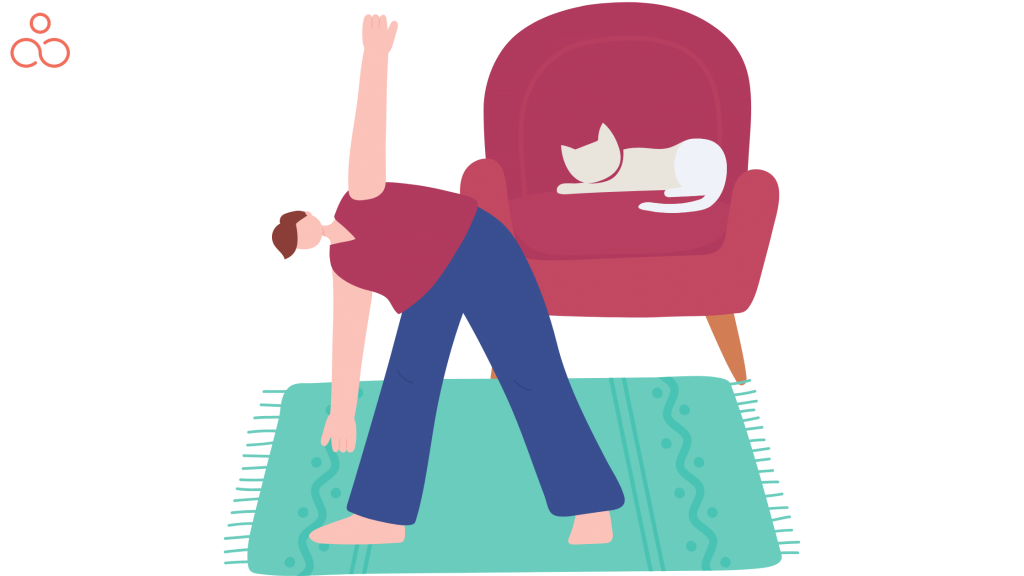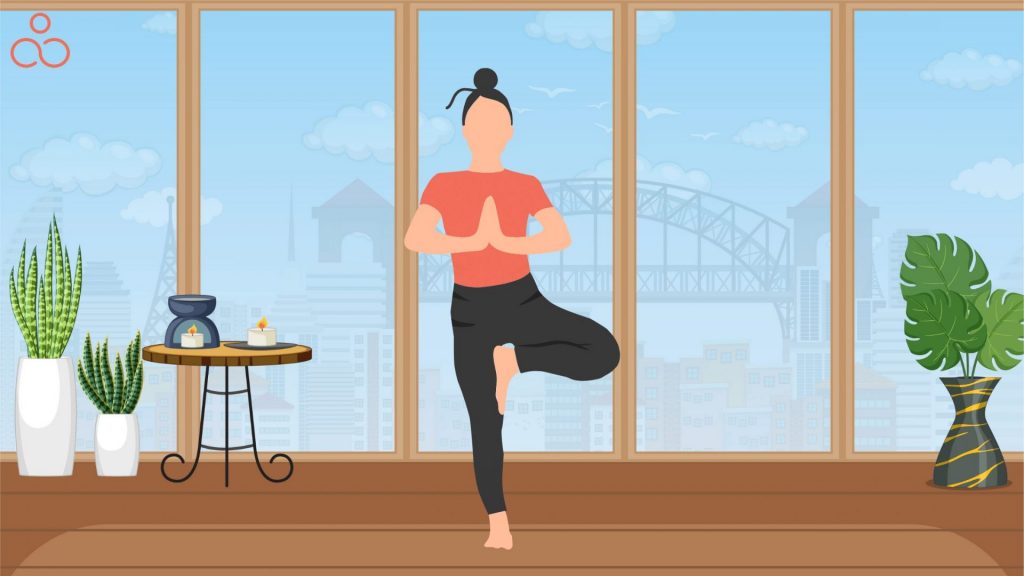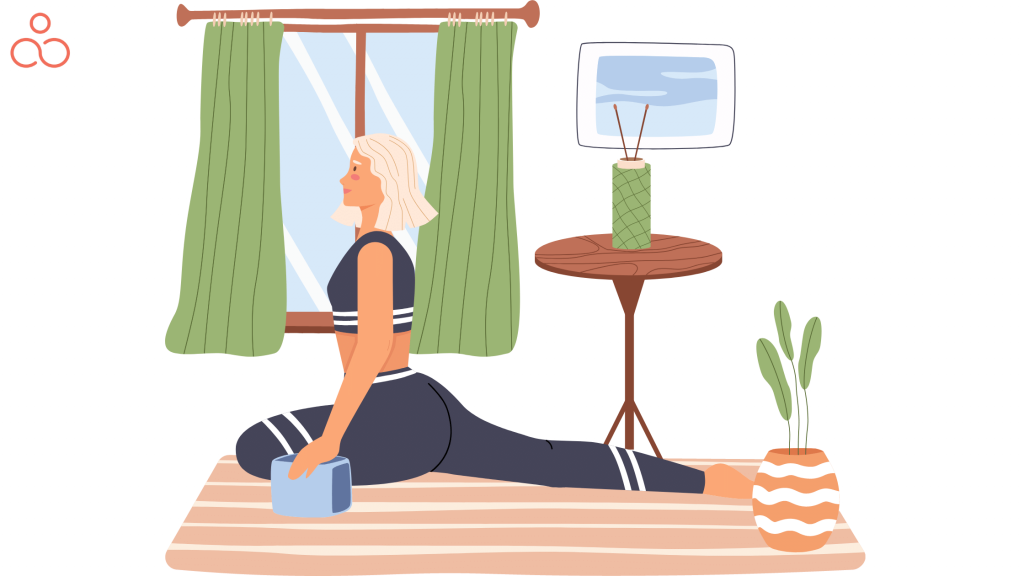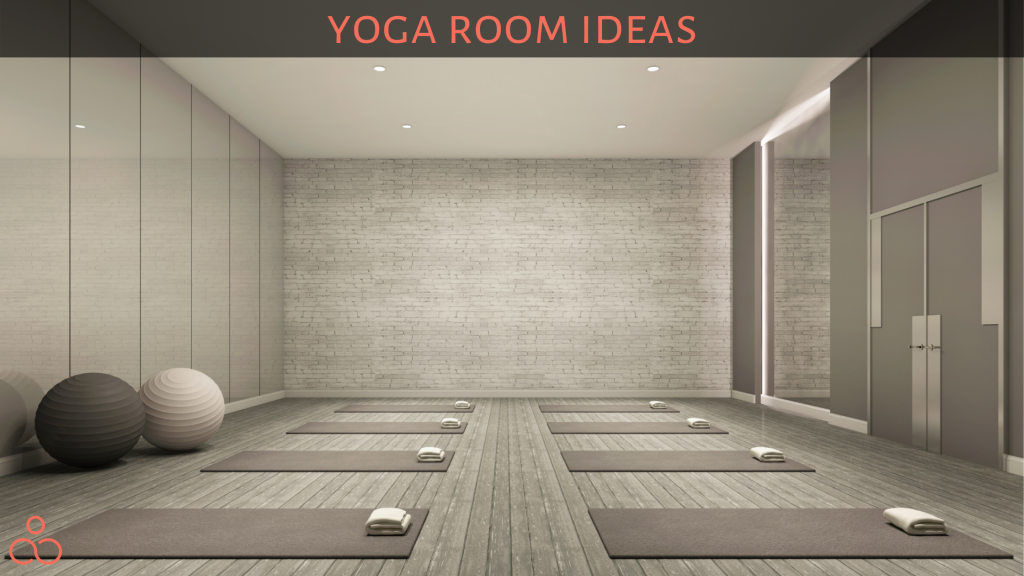One of the finest types of exercise for increasing flexibility and promoting inner serenity is yoga. Yoga can be practiced anywhere and everywhere as it hardly demands any gear. However, considering the issues like outdoor weather, hygiene, safety, and other things, most yoga practitioners prefer a specially designed space for their yoga routine. Today, we have come up with some interesting and amazing yoga room ideas that will help you set up and design the appropriate space to relax, rejuvenate, and refresh while kicking in the right motivation toward life.
Do I really need a specific space exclusive to yoga practice?

A holy, tranquil setting that helps us relax and enter a calm frame of mind, away from the stresses of the outer world, is where we should practice asanas in order to reap the best benefits of the practice. To put your brain in “yoga mode,” things like lighting, colors, aromas, and visual arts have remarkable influence. A dedicated yoga room creates the ideal environment for reaching your objectives, whether they involve stress reduction, the need for a strenuous workout, a spiritual connection, or all of the above.
Identifying Your Yoga Space

Before jumping in to find out what could be done to transform a space into a yoga zone, it is necessary for you to understand the usability and access of the space that is to be created. A yoga room could be a section in the gym, a dedicated space in a society with limited access to its residents, a room in your house for all your family members, or even a small personal space in your apartment exclusively for you!
Designing the yoga room majorly depends on how big the space is and how many people would be using the same. However, the aspects that we would be covering here in the following sections can be incorporated into either of these situations and all the yoga room ideas can be partially or even completely implemented to bring in the vibe.
Here are some points to remember while designing a yoga space:
- Surface and Floor Plan – The climatic conditions of the place you choose play a crucial role in deciding the type of floor surface you might want to go for. While some practitioners prefer wooden flooring others recommend a carpeted surface. The cost involved could also majorly vary depending on the floor plan and the number of people the space might accommodate. Check with a design expert to understand the cost-effectiveness and functionality aspects before finalizing this aspect.
- Wall Color and Décor – The colors of the space tend to have a huge impact on the mind. Planning for soothing colors and natural hues are recommended for your yoga room walls. Yoga is a simple and soothing form of exercise. To match the vibe right, try to have a minimalistic décor approach and avoid bright and strong statements of expressions through colors or décor.
- Lighting and Ventilation – Considering this fitness regime to have a lot of emphasis on breathing the right way, it is also important to breathe in the right air! An ample amount of ventilation allows air circulation, bringing in the fresh air, and keeping the place pleasant and calm. Dark spaces bring in dark and negative thoughts. Have you ever wondered why nightclubs are always dark and your eyes dazzled with bright hues of crazy lights and loud music? You get a different kind of high vibe there but you never feel calm and relaxed. Natural lighting and well-lit places bring in a lot of clarity in thought and calmness to the mind. Plan the design aspects accordingly!
- Acoustics and Aesthetics – Have you ever been to a posh restaurant or high–class medical facility? You might have noticed a small water fountain at the entrance or a lot of green spaces in their interiors. We instantly tend to feel relaxed and start feeling comfortable with the place. It is all because of the right acoustics and aesthetics. Nature in all its forms like the sound of gushing water or chirping birds adds great value to the entire yogic experience.
While all of these above-mentioned basics are applicable to any type of yoga set up like a studio in the gym or a yoga room in your apartment, we have come up with some exclusive tips that might be helpful exclusively for creating a personalized yoga room in your home. Considering the fact that we have all become accustomed to work-from-home or prefer working out at our comfortable space and time, these tips have been curated to help you create your unique space for rejuvenation flawlessly:
- All you require is a space that’s 7×7: You may simply build a cozy environment to practice yoga as long as you have at least a 7 square feet area. Make sure there are no distractions when you practice your poses be it a notification from your mobile phone or television that is constantly making noise. The atmosphere of a yoga studio may be greatly enhanced by adding the right lighting, an oil diffuser, and relaxing music. Add some plants, gemstones, tapestries, or anything else that makes it feel very personal to take it a step further.
- Pick a specific area and time in your home for yoga: Even if your area is modest, like right next to your bed, simply organizing it and adding a plant may have a significant impact. It is much simpler if you can designate a certain area for practicing and set out a time to do so, just like you would in person. Inform your roommates, if any, of the value you have on your yoga practice. Home practice can be difficult since there are so many things to remember to accomplish. Give yourself great credit for maintaining a practice at home. For more ideas watch clip.
- Positioning near a wall: Having access to the wall throughout your practice may aid with balance, flexibility, backbends, and inversions. In my view, the wall is the most underestimated prop. When attempting to enter a complex pose, things that inspire you or aid in your attempt are also crucial.
- Everything needs to be accessible: Maintain a water bottle, a basket of Myofascial pain release tools, a variety of props, a meditation cushion, and blankets close at hand beside your yoga mat. You want the area to be warm, orderly, and available to help you at any time.
- What matters most is your immediate environment: Contrary to popular belief, setting up your yoga space does not need to require making a separate room in your house for it. What is crucial is that you practice in a peaceful, serene setting so that you can concentrate on your breathing and practice.
- Make a place you want to be in: Your area may be made more welcoming by having a lovely view of the outside or by creating a calming atmosphere with candles and/or essential oils. Additionally, for the sake of convenience keep all of your preferred props like blocks, blankets, bolsters, and eye pillows accessible in one location so you may get them easily whenever you visit your mat. It is important to design the space according to your taste and choice and not purely go by the internet. For example, one might like to have a Buddha statue or painting in their yoga room while others might prefer simple scenery or abstract paintings.
- Be thoughtful with your décor: To draw the senses inward, keep it as uncluttered and uncomplicated as you can, adding minor but deliberate ornamental elements. We would recommend organic, opulent accents that would pass for minimalist design but would pamper you in the time you set apart for yourself. Your space should be a reflection of the fact that practicing yoga is a form of self-care.
- Make your surroundings serene and calming: There needs to be a tranquil atmosphere that is entirely different from the rest of the home to establish an at-home yoga environment that makes you feel like you’ve left your bedroom and entered a wonderful yoga studio. Set up your space with earthy components like indoor plants or ornamental driftwood, soft hues, subdued lighting, and earthy décor for a pleasing visual approach. You can also add layers of touch to your yoga room to enhance the visual effects, such as plush blankets for savasana or Corpse Pose, mala beads for meditation, or burning lovely scented candles to help create the right atmosphere.
- The yoga studio is where little is more: It doesn’t take much to produce a place that is peaceful and conducive to practicing yoga. Setting the environment with minimal clutter, gentle lighting, and calming music is a terrific start. You’ll be more than prepared to perform downward dog in your serene haven of Zen if you add a calming candle or essential oil diffuser. Refrain from using loud decor, add calming colors, and get rid of devices and other things that might be stressful or distracting.
- Utilize a range of colors: Fuel your practice with the energizing hues of the chakra rainbow. Decorate your environment with objects, books, and flowers in vibrant colors of chakras to feel connected with those energies. You’ll be attracted in visually, which will make you desire to practice yoga even more.
- Use plants to add personality: in addition to promoting mental and physical health and reducing stress, plants help us feel more connected to nature inside of our own houses. The green foliage is also scientifically proven to bring a sense of calmness and clarity to our thoughts. The study also shows that the psychological impact of green is a lot more positive and calming.
- Your designs for a yoga room don’t need to be flawless: It’s nice to have a designated practice area at home, along with candles, aromatic oils, and your children in the closet. But we advise you to let go of the need for perfection every day. If in case your kids are running around or your pet wants to stretch along with you, it’s absolutely fine. Do not stress! Put your mat down and experiment freely. Consider it an opportunity to create some fun moments while getting healthy together.
Yoga Essentials To Incorporate In Your Yoga Room

It doesn’t really matter if you have a potted plant or not to start your yogic journey but it is essential to have certain gear and props to kick start as a beginner and to ensure a safe experience. Here is a quick checklist to assist you in gathering everything you need to set up your own yoga studio:
- Yoga mat: Using the appropriate yoga mat is really important and we wouldn’t recommend beginners to do yoga without a mat. As you reach an expert level you might want to experiment with different surfaces but it is always safe to use a proper yoga mat. To understand how to pick the right mat, check our article on
- Yoga Towel: They sit on top of your yoga mat and are excellent at absorbing perspiration and to prevent slipping. Look out for some organic cotton towels that are safe for you as well as the environment.
- Yoga Straps: In some positions, you might wish you had an “arm extender,” therefore a yoga strap is useful! Most of the time, a 6-foot yoga strap is sufficient, but if you’re tall, specialists suggest choosing an 8-foot strap.
- Yoga Blocks: One or two (preferably) yoga blocks are fantastic for extending your arms and lifting your feet off the floor to add a little extra space to your poses. They are also excellent for sitting in different seated poses, including meditation, and providing the right support in restorative postures.
- Yoga Blanket and Bolsters: Nothing is more opulent for doing restorative and yin yoga than having your blankets and bolsters. We prefer to make the blankets thick and strong and the bolsters extra-large so they may be used in numerous ways.
- Room Divider: A room divider or screen may be useful if you share a living space with others and if you want to practice in a bit more privacy.
To set up the ideal yoga studio at home, you don’t need to rush out and buy all these things. Instead, examine your yoga area and add furniture as needed to improve your practice.
12 Yoga Room Décor Ideas

- Seven Chakra Wall Art Set – The seven chakras or energy centers in our bodies remind us constantly, how much emphasis we are supposed to give in taking care of our body. Investing in a seven-chakra poster, painting, or embossed wall art will not only improve the aesthetics of your yoga room but will also keep you motivated and consistent with your practice.
- Crystal Sun Catcher – A dreamy world is a fascination for many. What if you can turn your yoga space into a mini dreamland with wonderful hues radiating from the crystals? Isn’t it amazing! Try to make your own crystal sun catcher or grab one from a flea market and experience the magic it does to your space.
- Surya Namaskara and Chandra Namaskara Posters – These two sequences are the basics of all other sequences and almost every yoga practitioner is sure to follow them. Having a printed poster stuck to a corner brings in the right vibe while also reminding you not to ever forget your basics.
- Metal Wall Décor – With yoga gaining popularity over the decades, we tend to see a lot of metal wall art pieces like meditating Buddha, lotus, Aum, Tree of Life and so on that remind us of the very basics of yogic practices. If you would like to experiment with a contemporary look then you could always look out for metallic figurines in yogic poses. Remember, that this stuff could also burn a hole in your pocket, and go for it only if you are sure to have them in your space.
- Green Corners – As already mentioned several times in this article, plants are the perfect option that we would always recommend having around in your yoga room. Though they require a little more time for watering and grooming, they give you multifold benefits. The green you see will have a psychological impact on your mind. The plants purify the air around you and improve the quality of your yogic experience. Additionally, they keep you closer to nature and bring in a very earthy look to your space.
- Eco-Friendly Furniture – While yoga is treated like just another fitness routine, we strongly believe that is a way of life. And therefore we recommend you invest in furniture that is environmentally friendly. Try opting for cotton rugs, and cane stools, when compared to non-friendly plastic and PVC furniture.
- Functional Organizers – Invest in some smart organizers to keep your yoga room clutter-free. You might want to have a stock of aromatic oils, incense sticks, napkins, towels, and more in the same room but having them all lying around in front of your eyes is not going to create a pleasant experience.
- Design Elements – Ensure all your other design elements such as ventilation, lighting, and colors of the walls are taken care of to blend in with your theme, be it traditional or contemporary.
- Soothe your Senses – Always try to practice by creating a soothing and comforting experience for your senses. Light some mild aromatic oil lamps or incense sticks. If you would like to have a more relaxing experience, you can just light the room with a few oil lamps and nothing else to give dim lighting but sufficient enough for you to be lost in a world of yourself.
- Trackers to Help – Do keep a measuring tape and a weighing scale hidden in a corner for you to track your weight loss and inch loss. Also, try to have a large-sized mirror installed on one side. It not only helps you see your posture for any corrections or to even flaunt the flexibility that you achieve over a period. Basically, these tools help you fall in love with yourself all over again rather than having a quantitative measure.
- Relax In-and-Out – When in the final corpse pose or savasana, try to stay a few minutes longer and see if you can have a cool eye pad to relax your eyes while you stay there feeling each part of your body. Relax your thoughts and body to completely rejuvenate in-and-out.
FAQs
Is it really necessary to have a dedicated yoga room?
If possible, yes. Yoga is not demanding but when given the right importance by setting up an appropriate space, time, and ambiance, you are sure to have an awesome experience with the process.
What colors would best suit a yoga room?
Pastel hues, muted tones, earthy shades, and whites are the best colors we would recommend for your yoga room. Though it is a personal choice, we don’t recommend choosing loud and bright colors.
What are the must-haves in my yoga room?
Yoga mat and you are the only must-haves in your yoga room. Everything else is just an addition but worth it when it comes to improving your safety and experience.
Which wall décor is apt for my yoga room?
Motivating or inspiring wall décors like the seven-chakra wall art or poster of some inspiring words could be great. However, if you wish to stick a picture of yourself to remind you how much weight you must lose and find that motivating, then go on! There is no hard rule on decorating your yoga room.
Should I use too many artifacts or décor pieces in my yoga room to make it look aesthetic?
Too many wouldn’t be good as it might look cluttered. Invest in artifacts that you genuinely connect to and not something that is simply hanging under the yoga décor section. Even one or two simple wall frames or corner pieces might do the magic to your space.
Should I use an air-conditioner in my yoga room?
We personally don’t recommend it as the quality of the air might be compromised. However, if you are living in places where it’s hotter then don’t hesitate to install one as otherwise, you might actually lose your interest in working out or staying consistent.
Conclusion
Making a personal yoga space in your house is only the beginning of developing a closer relationship with your inner self and discovering your pleasure. Regular yoga practice is necessary. Repeatedly engaging in the exercise helps you become more self-aware and improves how you interact with the world.

